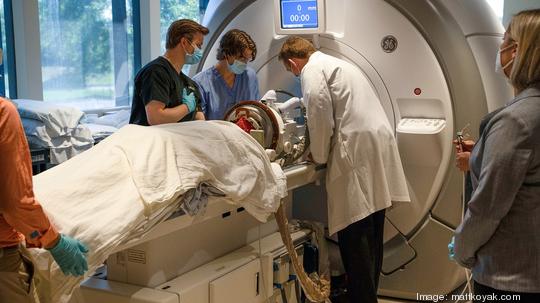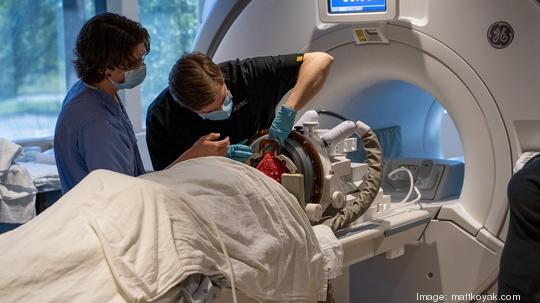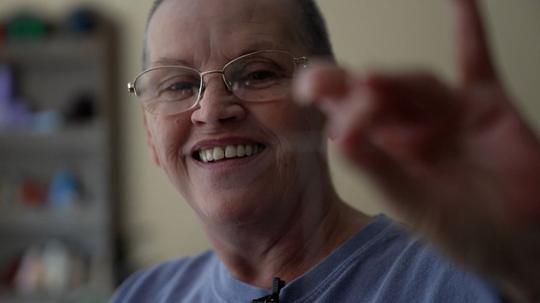
The patients arrive at Regional One Health with uncontrollable hand tremors. The shaking is debilitating: They struggle to sign their name on intake forms; they need help to drink from a cup of water. They talk of lost hobbies, confidence and independence.
Three hours later, they head home, their hands steady and their futures brighter. In the days that follow, they go out to eat at a restaurant for the first time in years. They start sewing a quilt for a grandchild. They go to church and take communion without assistance.
It may sound like magic, but it’s actually scientific and medical innovation at work.
Focused ultrasound, a procedure proven to provide lasting relief for hand tremors from essential tremor or tremor-dominant Parkinson’s disease, uses MRI and ultrasound technology in a new way to provide relief without medication, surgery or hospitalization.
“Our patients are at a point where the tremor is affecting their quality of life and they’re looking for a solution to give them a little piece of themselves back,” said Dr. Douglas Taylor, the neurosurgeon who leads Regional One Health’s focused ultrasound program, the only one of its kind in the mid-South. “This is something we can do that directly improves their quality of life.”
Focused ultrasound is an example of finding a new use for existing technology to provide better patient care.
Physicians have long used ultrasound and MRI for screening and diagnosis of various conditions, but it was just within the last decade that clinical trials led to approval of a system that combines the technologies to treat the part of the brain responsible for hand tremors.
Focused ultrasound uses highly-accurate MR imaging to locate the exact spot in a patient’s brain that causes their tremor – the VIM nucleus in the thalamus.

Then, the ultrasound waves get to work. Since they can pass through the skull and surrounding tissue safely, they are the perfect technology to treat the VIM nucleus via a small ablation.
The high-tech procedure is impressively low-key from a patient perspective.
Taylor starts by consulting with the patient to see if they are a good candidate. Patients must be 22 or older with a confirmed diagnosis of essential tremor or tremor-dominant Parkinson’s and need to have tried medication without getting relief. Taylor also performs a CT scan of the skull during the consultation in order to make sure the density is compatible with treatment.
If a patient meets those qualifications, they can schedule their focused ultrasound, which is a qualifying treatment under Medicare and most private insurance plans.
On the day of the procedure, Taylor and his team start by shaving the patient’s head and fitting them with a specialized helmet that circulates cool water around their head. These steps allow the ultrasound waves to pass easily through the skull.
During the procedure, the patient is awake and lying still on an MRI bed. The upper half of their body passes in and out of the MRI several times over two to three hours as Taylor performs a series of sonfications or applications of ultrasound energy.
After each sonification, Taylor asks the patient to complete a simple task, like drawing a spiral or using their finger to touch his finger. This shows him how well the procedure is working so he can make adjustments if necessary.

When the focused ultrasound is over, most patients experience immediate, lasting relief.
“It’s a wonderful thing they’ve come up with,” said Jerry Mitchell, who underwent his focused ultrasound in 2021. “When you’re shaking, you have trouble doing all those little things you need to do. The biggest thing for me was shaving and I got to the point where it was hard to eat. This makes everything so much better.”
Cheryl Peacock, another focused ultrasound patient, said, “The tremors affected every part of my life, and I thought it was going to be that way forever – or get worse. But I came out of it and felt like a new person. It changed my life 100 percent for the better.”
Clinical trials show improvements in tremor and quality of life continue long after treatment.
Researchers state that at three months, patients had a 47 percent improvement in their hand tremor, which was sustained at one year. Patients also had a 63 percent reduction in their total disability score and reported dramatic increases in their quality of life.
Visit www.regionalonehealth.org/fus/ to learn more about focused ultrasound.
Regional One Health provides accessible, efficient, quality care for the Mid-South. Its main campus in downtown Memphis features comprehensive medical services and centers of excellence in trauma, burn, NICU and high-risk obstetrics. Its east campus provides specialty care and other outpatient services, and the system offers six primary care offices.
